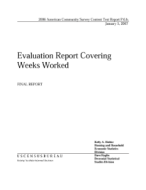Evaluation Report Covering Weeks Worked
Evaluation Report Covering Weeks Worked
Executive Summary
Test Objective
- In January through March of 2006, the American Community Survey (ACS) conducted the first test of new and modified content since the ACS reached full implementation levels of data collection. The results of that testing will determine the content for the 2008 ACS.
- The chief purpose of the weeks worked question is to establish a framework for the earnings data collected in the ACS. This item is specifically used to identify ‘full-time, year-round’ workers. A ‘year-round’ worker is defined as someone who works 50 to 52 weeks, including paid time off. Evidence suggests the ACS underestimates year-round workers compared with estimates from the Current Population Survey (CPS).
- The overall objective of the 2006 ACS Content Test for the week worked item was to bring the ACS estimates closer to the CPS estimates, without a significant decrease in data quality as reflected by an increase in response errors and nonresponse rates.
Methodology
- Weeks worked is the central question in a battery of three questions that collects work experience data.
- The content test compared two versions of the weeks worked question.
o The control version replicated the current production ACS question, which allows an open-ended response.
o The test version modified the weeks worked question by separating the original question into two parts. Part (a) asked whether the respondent worked 50 or more weeks in the past 12 months. Respondents who answered ‘no’ to part (a) were asked part (b) of the question to discern how many weeks they did work, even for a few hours. This modification was an attempt to capture more temporary, marginal, or casual workers who may have only worked briefly and forgotten to include weeks in which they worked for only a few hours. - The content reinterview attempted to get at response bias, and asked questions based on the more detailed weeks worked sequence in the CPS.
Research Questions and Results
- Question: Do all of the changes to the weeks worked question taken together increase the estimates of year-round workers.
Results: The percentage of people 16 years and older who were year-round workers (50- 52 weeks) was higher in the test panel than in the control panel at the national level. iv - Question: Do the changes to the weeks worked question taken together adversely impact the item nonresponse rates?
Results: There was no significant difference in nonresponse rates at the national level between the test and control panel. - Question: Do the changes to the weeks worked question reduce response error (bias) in the estimates of weeks worked?
Results: The net difference rate for year-round workers was lower in the test panel than in the control panel. - Question: Do the changes to the weeks worked question adversely impact the income series questions? (For informational purposes only.)
Results: There was no difference between the panels in median earnings for full-time year-round workers. - Summary: The selection criteria were based on the results from changes to one question in the work experience series—weeks worked. Our goal was to produce a higher estimate of year-round workers, bringing the ACS closer to the CPS. In addition, we wanted to accomplish this without a decrease in data quality. The results support our selection criteria. The test question produced a higher estimate of year-round workers, an equal, though not better, nonresponse rate, and lower response error for the year-round worker category. These findings indicate that, empirically, the test version of the weeks worked question performed better than the existing ACS question.
Others in Series
Working Paper
2010 ACS Content Test Evaluation: Behavior Coding Results
Behavior coding results from the 2010 American Community Survey Content Test.
Working Paper
Evaluation Report Covering Health Insurance
Results of the proposed addition of health insurance as tested in the 2006 American Community Survey Content Test.
Working Paper
Evaluation Report Covering Place of Birth, Citizenship, & Arrival
Results of proposed changes to the place of birth, citizenship, and year of entry content as tested in the 2006 American Community Survey Content Test.
Page Last Revised - October 8, 2021




